
Continuous Improvement
22 min read
Continuous Manufacturing: Streamlining Production for A Competitive Edge
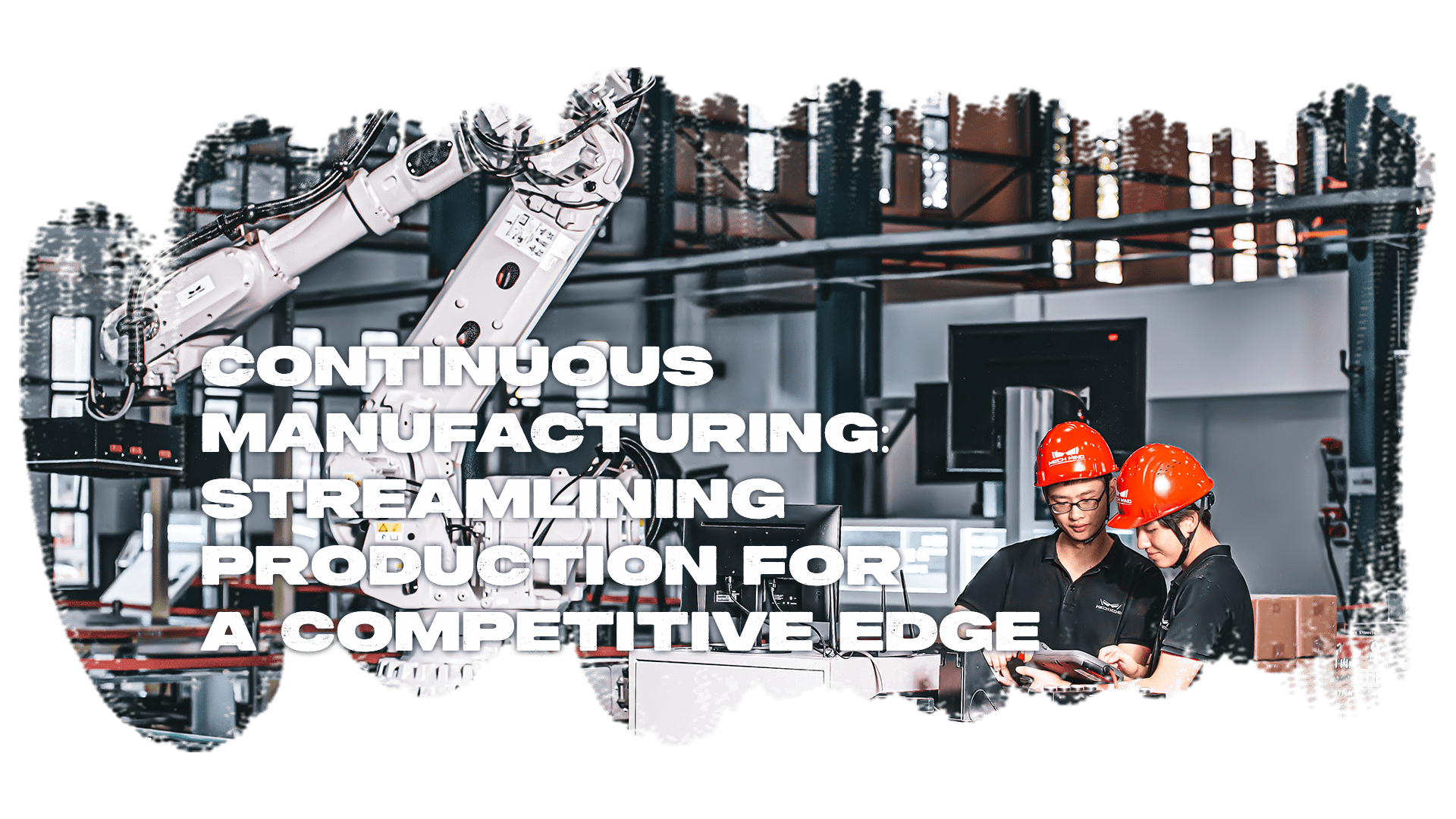
Continuous manufacturing (CM) is a production method that has gained a lot of attention in different industries due to its ability to streamline production, enhance profits and competitiveness.
Table of Contents
1. Advantages of Continuous Manufacturing
2. Disadvantages of Continuous Manufacturing
3. Scaling Up from Batch to Continuous Manufacturing
4. Essential Components & Technologies in Continuous Manufacturing
5. Implementation Challenges & Considerations
6. Cost Savings & ROI of Continuous Manufacturing
8. Is Continuous Manufacturing Right For You?
CM involves nonstop production without interruptions or pauses between batches, utilizing constant use of machinery and minimal process variation for different products.
Investing in continuous manufacturing is given to remain competitive in fast-growing industries such as pharmaceuticals, which are expected to reach USD 2.3 billion by 2027. Investing in continuous manufacturing is a given to stay competitive.
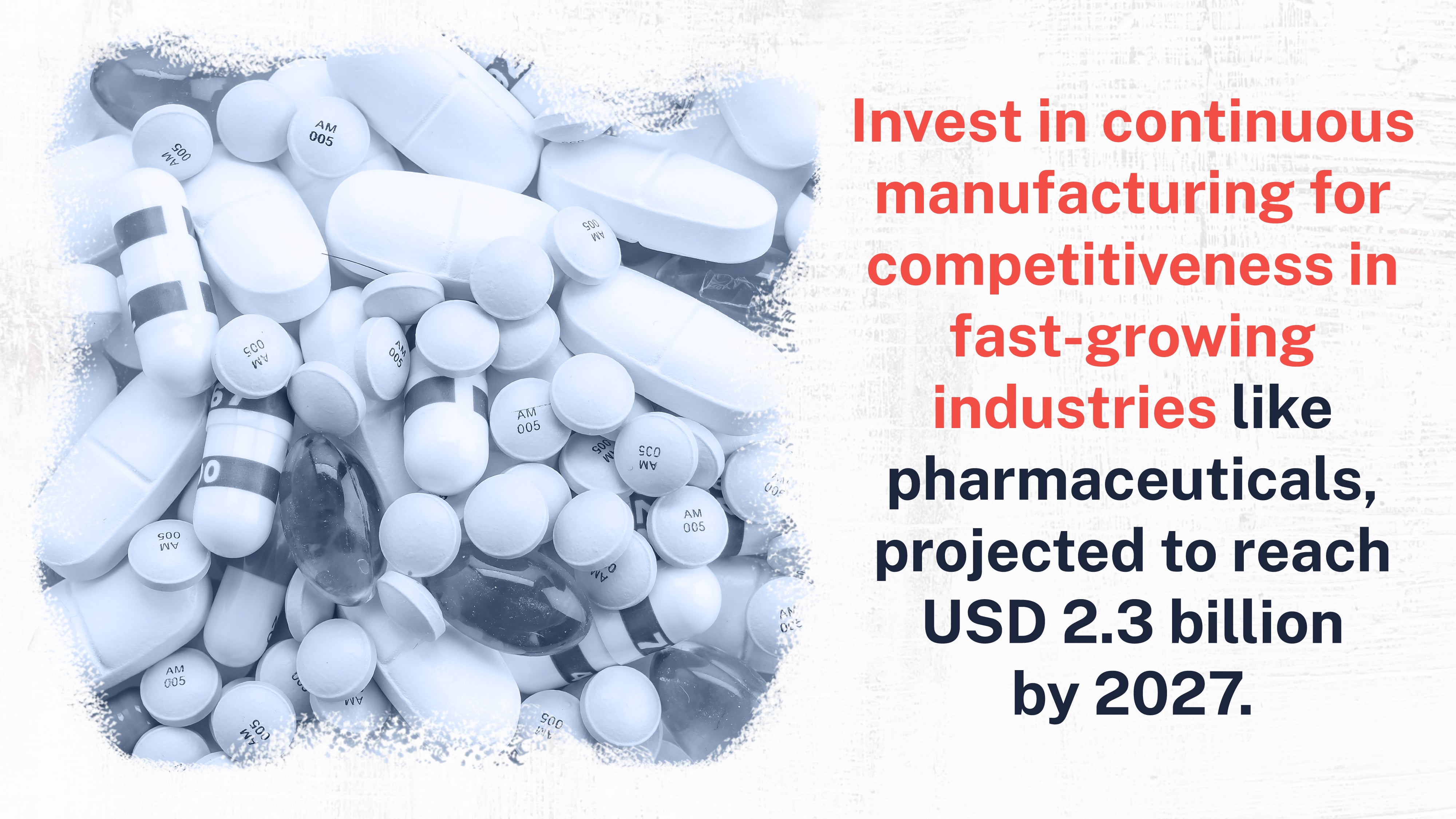
The advantages of continuous manufacturing include lower manufacturing costs, faster production, improved scalability, and greater utilization of automation and predictive maintenance.
'Also, it enables customization through advanced tools based on AI, predictive analytics, predictive maintenance, and robotic process automation, often referred to as RPA.
By leveraging smart machinery and technologies like artificial intelligence, machine learning, and IoT (such as industrial sensors with integrated sensor and computing functions) sensors, continuous manufacturing helps the production of customized goods with traceability and increased efficiency.
There are also limitations with this method, such as limited customization options and challenges in scheduling maintenance without disrupting the production flow.
Despite these issues, continuous manufacturing offers efficiency gains that can significantly contribute to the profitability and competitiveness of industries adopting the CM approach.
Despite these new problems, batch manufacturing still provides greater product customization and adaptation flexibility.
Each batch can be tailored to specific requirements or variations, making it suitable for smaller-scale production runs or when the production process requires frequent adjustments. Also, batch manufacturing is typically easier to implement and requires less initial investment in equipment and technology.
While there are several benefits, it can result in inefficiencies due to downtime during changeovers and increased lead times between batches, impacting overall production rates and costs.
Not only that, but the quality control process may be more time-consuming, as each batch requires individual testing and inspection before it can be released to the market.
Advantages of Continuous Manufacturing
One advantage of continuous manufacturing is its ability to optimize production efficiency and reduce costs through streamlined processes.
Continuous manufacturing allows nonstop production without interruptions between batches, resulting in lower manufacturing costs and faster production. The constant use of machinery and slight variation in the process for different products help lead to improved automation.
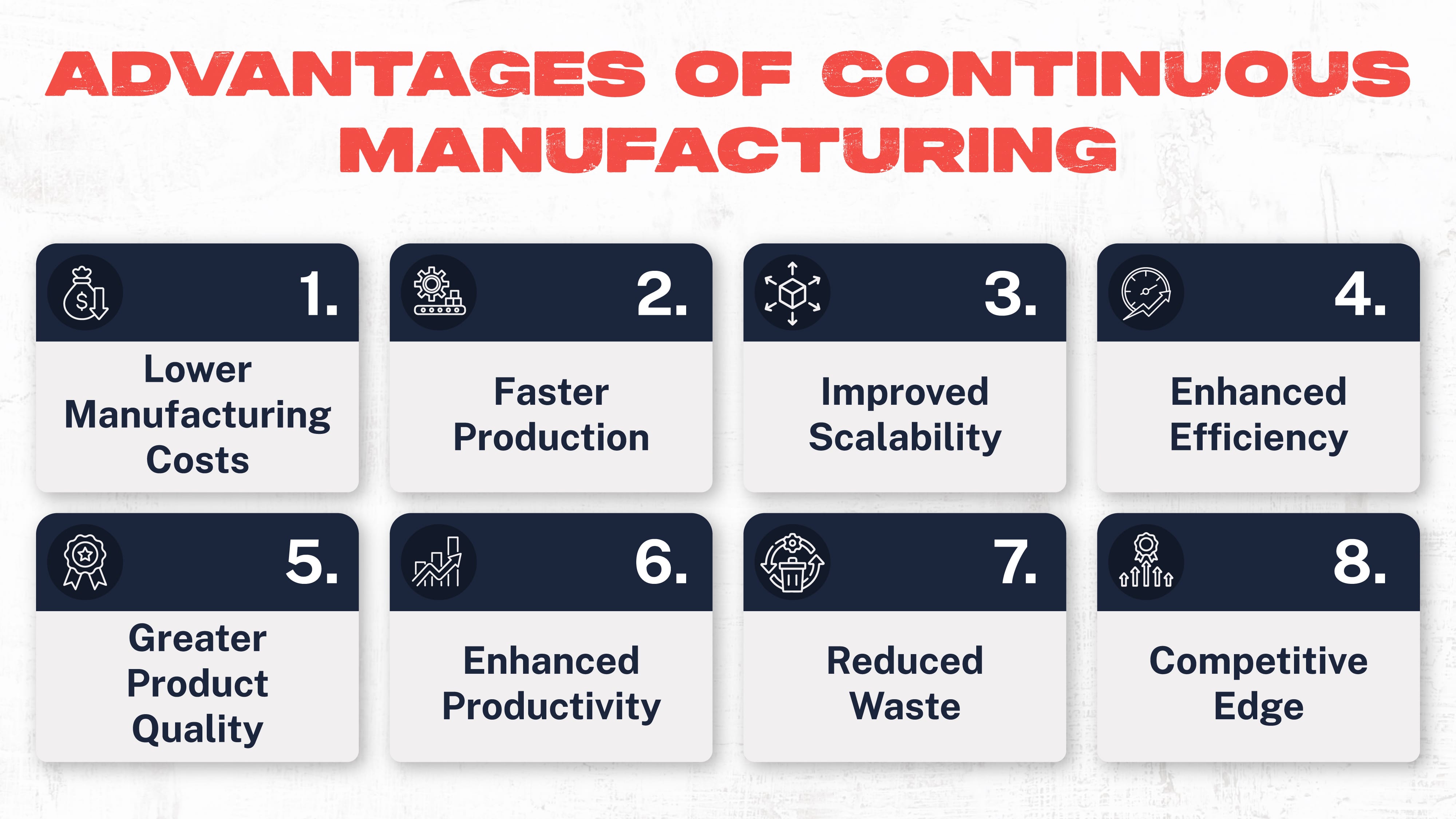
Disadvantages of Continuous Manufacturing
Continuous manufacturing also has its fair share of limitations that need to be addressed if we are going, to be honest.
First, the high capital investment needed to implement continuous production systems can act as a significant barrier for many companies, as it involves a significant initial investment in equipment and infrastructure and can even involve having to move to new facilities.
Not only that, but these systems are typically complicated to change, making them less suitable for businesses requiring frequent product alterations.
Additionally, continuous production systems can be complex and challenging to manage due to their intricate nature needing new training for mechanics.
One of the more essential issues to consider in the case of things like pharmaceuticals is that there is a higher risk of contamination in continuous manufacturing compared to batch production systems, which require careful attention and adherence to strict quality control measures.
Some of the disadvantages of continuous production include:
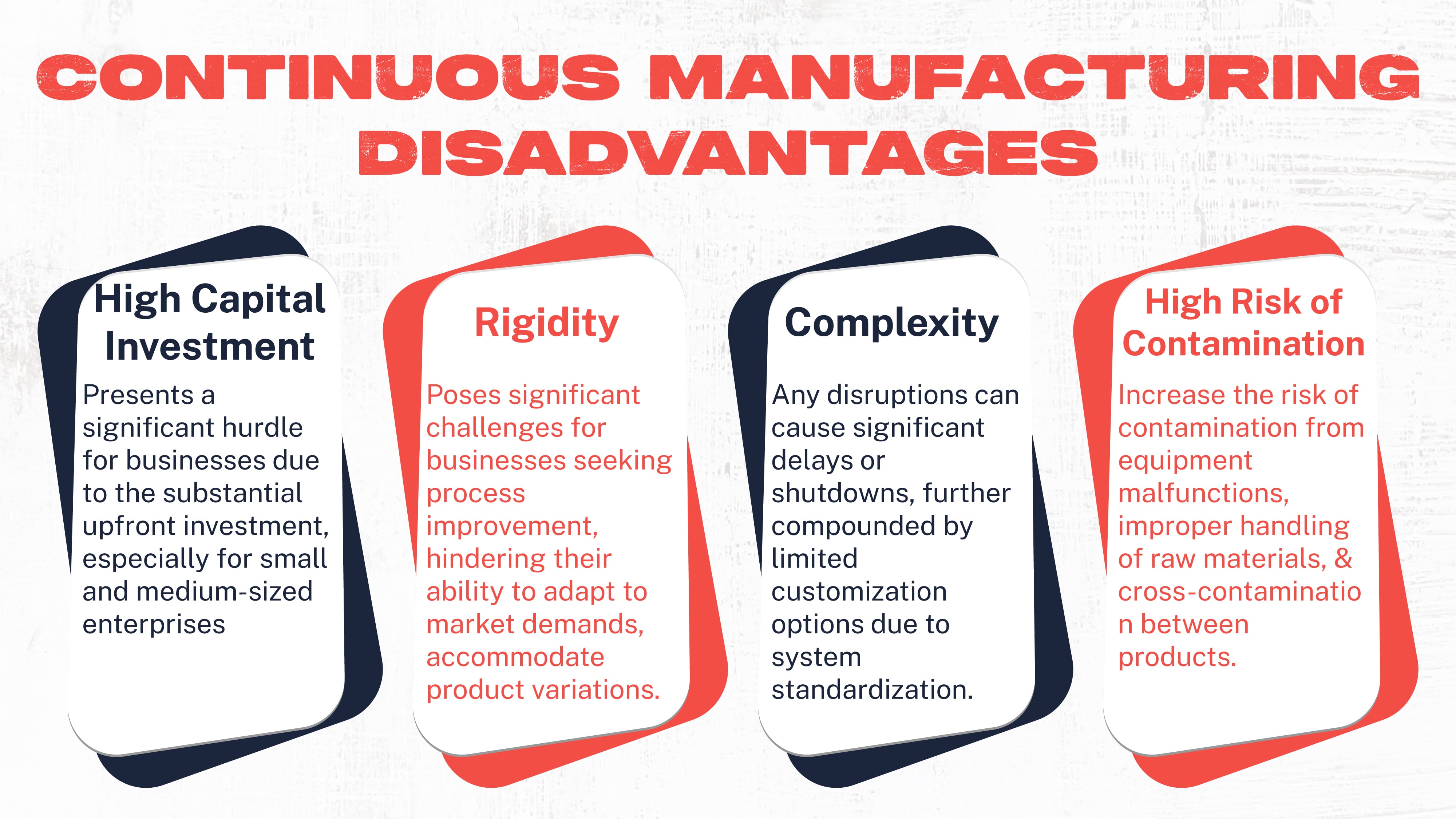
High capital investment:
With the implementation of continuous manufacturing, businesses face the challenge of a substantial upfront investment in equipment and infrastructure, which can make the transition a non-starter.
The high capital investment of continuous manufacturing can be particularly tough for small and medium-sized enterprises (SMEs) with limited financial resources.
However, it is essential to note that although the initial costs may be higher than batch systems, continuous manufacturing offers long-term benefits such as increased efficiency and reduced costs that offset these investments over time.
So, while the costs are high, your company should also investigate tax benefits and other incentives. Many companies are seeing an ROI as soon as a year.
Rigidity
The inflexibility of continuous production systems poses significant challenges for businesses looking for ways to improve their processes to meet market demands and product variations.
Continuous production systems are typically rigid and difficult to change due to the standardized system.
This rigidity limits the custom options for businesses using continuous manufacturing for many different items. These systems' fixed path materials handling equipment and balanced machine capacities further contribute to their inflexibility.
Businesses may find it challenging to introduce new products or make changes to existing ones without disrupting the production flow significantly to implement these changes.
This lack of flexibility can limit the ability of companies to respond quickly to market changes or meet specific customer requirements efficiently.
Complexity
Complexity is a given with most continuous production systems. With any technological upgrade, we generally assume things will be more complicated.
Continuous production systems are designed to operate without interruption, which requires a high level of coordination and synchronization among different processes and machines.
This complexity is a bit of a double-edged sword, as it is needed to ensure a smooth flow of materials and operations, as any disruptions or faults can lead to significant delays or even complete shutdowns of production. Still, when there are issues, it can cause longer delays than before.
To make things worse, the standardization of continuous production systems limits customization options, making it challenging for businesses needing frequent product alterations.
High risk of contamination
Unlike batch production systems, which allow for thorough cleaning and sterilization between each batch, continuous manufacturing operates without interruption.
This makes it more susceptible to contamination from various sources, such as equipment malfunctions, improper handling of raw materials, or cross-contamination between different products.
The risk of contamination can be awful for industries such as pharmaceuticals or food and beverage, where quality control can make or break a business. Strict adherence to hygiene protocols and equipment maintenance are essential to mitigate this risk.
Some of the potential challenges that are posed by a high risk of contamination include:
- Lack of pause between batches hinders cleaning.
- Improper handling of raw materials increases the risk of introducing contaminants.
- Cross-contamination between different products is more likely due to continuous flow.
Scaling Up from Batch to Continuous Manufacturing
When scaling up from batch to continuous production, the first consideration is whether you can do it efficiently. Not only that, but there may need to be more demand to purchase the increased volume.
Another thing to consider is whether or not your facility and team can accommodate the transition. You need to train staff and have room for increased production and equipment.
Once these things have been accounted for, there are some ways you can implement technology to help move along the process more smoothly.
Use a surge tank
A surge tank is a storage reservoir placed strategically in the production line serving as a buffer to accommodate fluctuations in demand and maintain a continuous flow of materials without interrupting the manufacturing process.
It helps you scale up from batch to continuous manufacturing by providing flexibility and stability.
The surge tank collects excess material during periods of high production and releases it during periods of low demand, ensuring a steady supply to downstream processes.
Regulating the flow rate prevents disruptions caused by fluctuations in demand or equipment failures.
Another benefit is that the surge tank can help optimize system performance by minimizing downtime and reducing the risk of blockages or work piling up.
Use a feedforward controller
Implementing a feedforward controller can boost efficiency and stability, allowing for precise adjustments in real-time to ensure optimal performance and minimize disruptions.
This control mechanism predicts disturbances or changes in the input variables and takes corrective actions before they can affect the output.
Using AI to analyze historical data, mathematical models, and predictive algorithms, a feedforward controller can anticipate variations in factors such as raw material quality, environmental conditions, or performance.
The benefits of using a feedforward controller include improved product quality by reducing process variability, increased productivity through faster response to disturbances, reduced energy consumption by optimizing process parameters, enhanced safety by preventing potential hazards, and overall cost savings due to better resource utilization.
Use a level controller
A level controller is designed to maintain a constant material level within a specific process or piece of equipment. Its job is to continuously monitor the material status and adjust the inflow and outflow rates accordingly to ensure stability and prevent overflow or underflow situations.
This helps by maintaining an optimal material level. The level controller helps to improve efficiency, reduce waste, and enhance product quality in CM.
However, it would be best to use caution as implementing a level controller requires careful calibration and monitoring to ensure accurate material level control throughout production.
Use a sound data acquisition system
Utilizing an effective data acquisition system is crucial for enhancing efficiency in the manufacturing process. A sound data acquisition system enables real-time monitoring and collection of data from various sources, such as sensors, machines, production lines, and more. This allows for accurate measurement of critical parameters you need to have running properly for efficiency.
The benefits of using a reliable data acquisition system include:
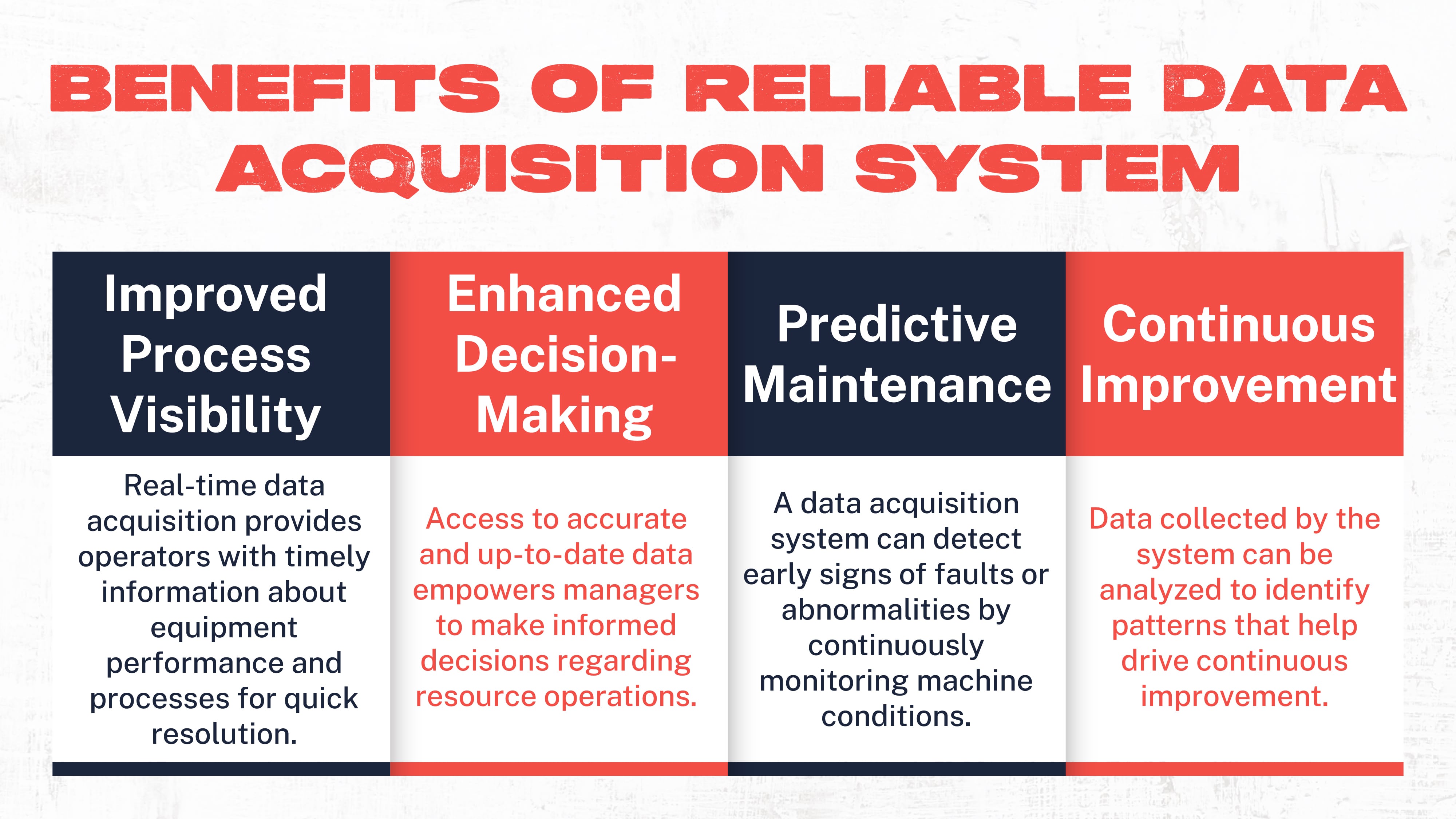
- Improved process visibility: Real-time data acquisition provides operators timely information about equipment performance and processes for quick resolution.
- Enhanced decision-making: Access to accurate and up-to-date data empowers managers to make informed decisions regarding resource operations.
- Predictive maintenance: A data acquisition system can detect early signs of faults or abnormalities by continuously monitoring machine conditions, allowing for proactive maintenance actions to prevent unplanned downtime.
- Continuous improvement: Data collected by the system can be analyzed to identify patterns that help drive continuous improvement.
A robust data acquisition system is vital in streamlining the continuous manufacturing process to achieve higher productivity and competitiveness.
Essential Components & Technologies in Continuous Manufacturing
Many vital components of CM are essential to be aware of, such as advanced machinery equipped with artificial intelligence (AI), machine learning (ML), and Industrial Internet of Things (IIoT) sensors.
These technologies enable real-time monitoring and control of production processes, allowing quick adjustments and optimization.
Automation and process analytical technology (PAT) is useful for continuous production. Sensor data analytics may help manufacturers increase productivity, quality, and security in their processes.
Predictive analytics tools can create a modular production system that can help become more productive with modular production. A manufacturing system that can make many products with little in the way of reconfiguration or changeover times is called a flexible manufacturing system (FMS) and is an essential aspect of continuous manufacturing.
Finally,, we have robotic process automation (RPA), which can automate repetitive tasks that reduce the need for manual labor and increase efficiency. Studies show that RPA can increase production yields by as much as 30%!
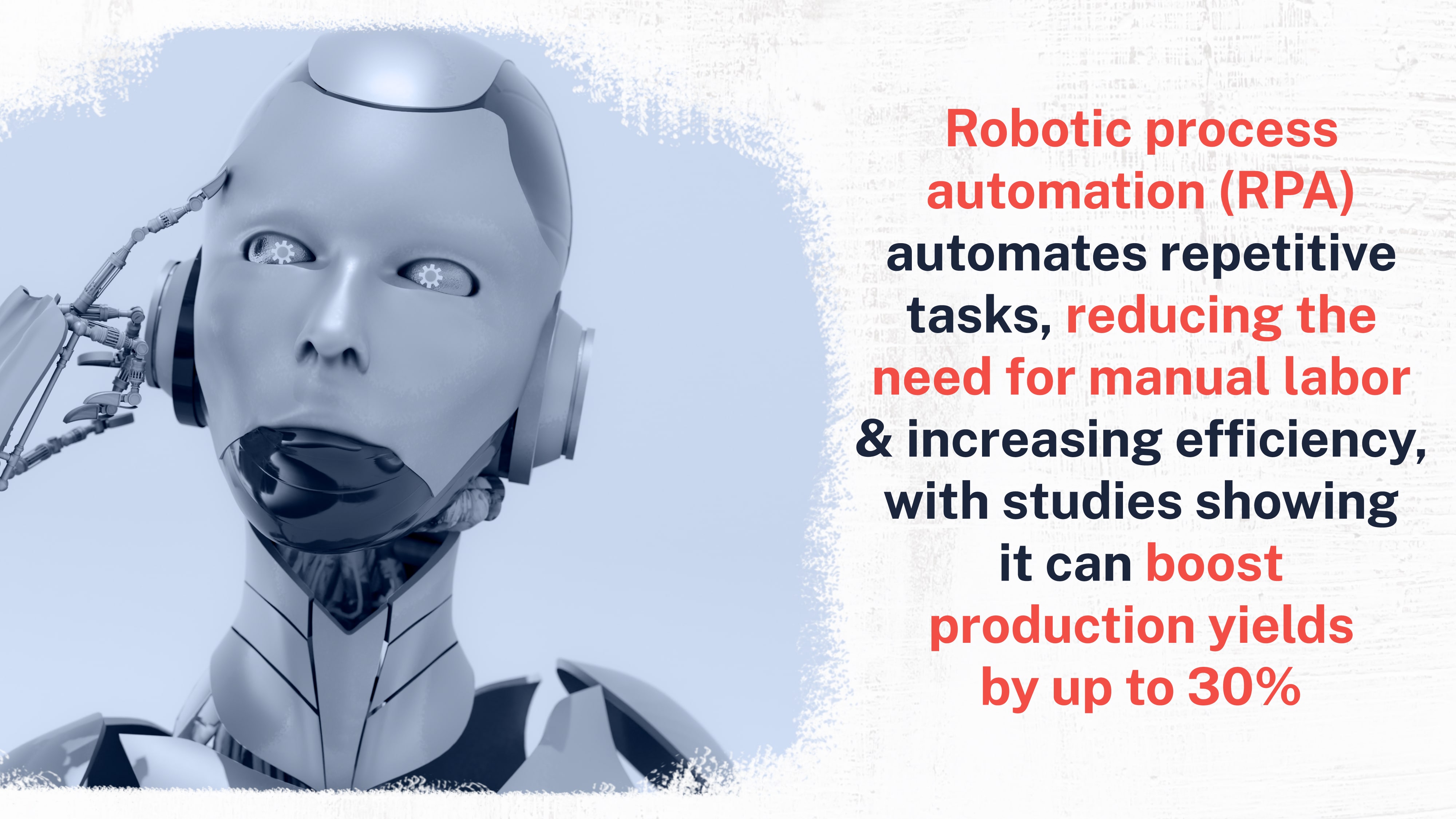
Implementation Challenges & Considerations
Implementing CM equipment means you need to have a complete analysis of excipient variability with pharmaceuticals, mainly when process control relies on signals from the excipients obtained through process analytical technology (PAT).
Implementation challenges and considerations in continuous manufacturing systems include thorough planning and coordination to schedule maintenance without disrupting the seamless production flow.
Properly scheduling maintenance can reduce potential risks associated with system faults that can lead to a complete shutdown of operations, which you do not want to happen for obvious reasons.
One problem is that customization options may be limited in continuous manufacturing systems compared to batch systems, which could pose a challenge for businesses that need to make product alterations for various reasons.
Despite these challenges, continuous manufacturing offers significant advantages in terms of:
- Efficiency
- Cost reduction
- Optimized production for high-volume industries such as pharmaceuticals, metalworking, and textiles
Cost Savings & ROI of Continuous Manufacturing
Cost savings and return on investment (ROI) are significant considerations.
It can’t be overlooked that these systems offer the potential for reduced manufacturing costs, increased automation, and improved scalability, ultimately leading to greater profitability and competitiveness through continuous manufacturing process improvement. Some ways CM helps create continuous improvement include:
- Reduced manufacturing costs
- Increased automation
- Improved scalability
- Greater profitability
- Enhanced competitiveness
According to this case study, the company Colombina experienced significant ROI, including a 13.8% increase in their overall production efficiency (OPE), a 26% decrease in work-related injuries and accidents, a substantial 69% reduction in variable manufacturing costs, and most impressively a 76% decrease in their product returns.
Future Trends & Outlook
Emerging advancements in technology and industry-driven innovations are shaping the future of manufacturing systems, offering new possibilities for the future of manufacturing.
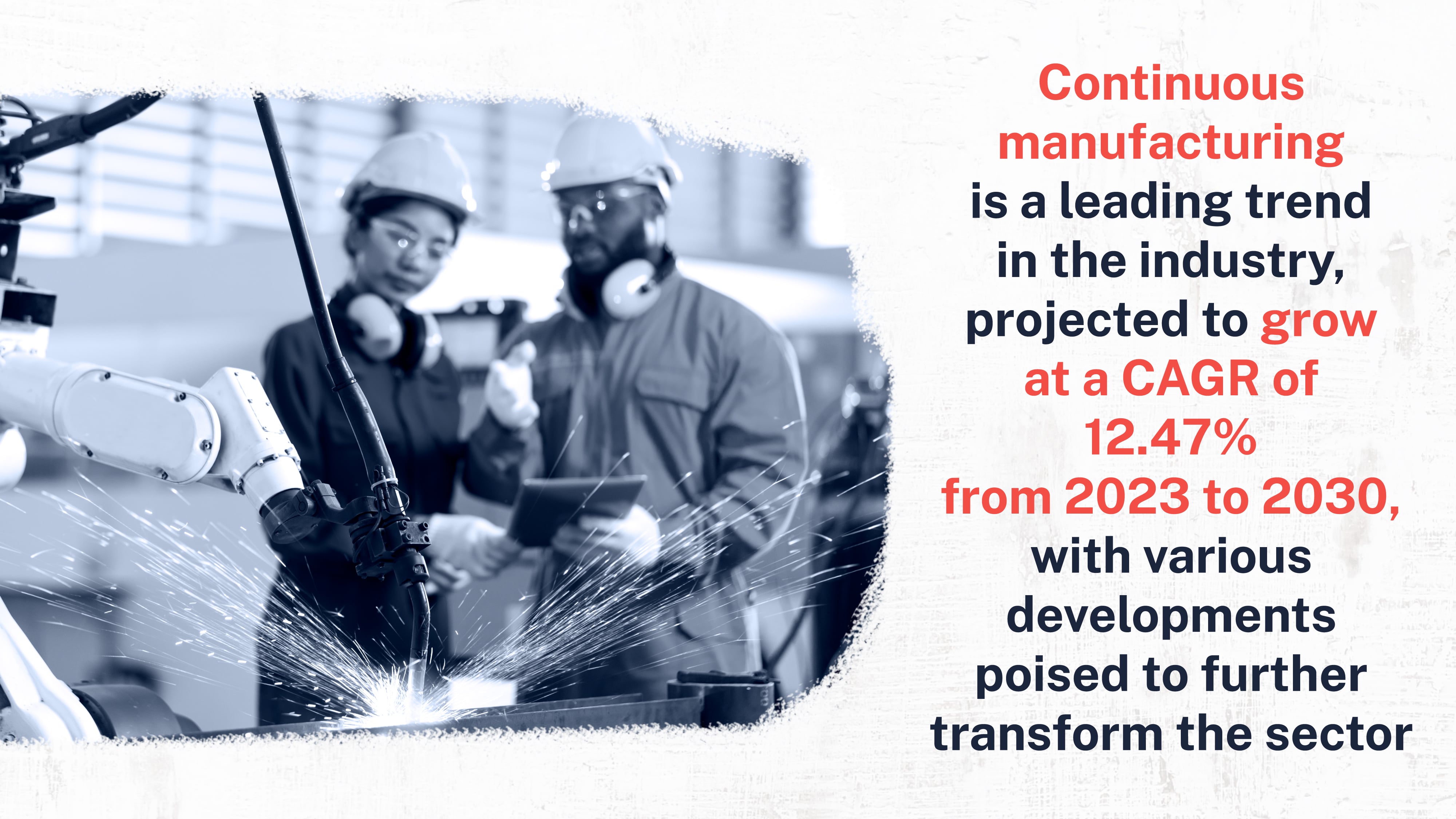
Continuous manufacturing is at the forefront of these trends; the industry is expected to grow at a compound annual growth rate (CAGR) of 12.47% from 2023 to 2030. Not only that, but several developments are poised to transform the industry further.
One such development is the integration of artificial intelligence (AI) and machine learning (ML) algorithms into continuous production systems. These technologies can optimize processes in real-time, detect potential problems before they cause disruptions, and enable predictive maintenance.
Additionally, the Internet of Things (IoT) plays a crucial role by connecting machines and devices throughout the production line, allowing for seamless data exchange and monitoring. This connectivity facilitates improved process control, timely decision-making, and enhanced traceability.
Another consideration is that continuous technological improvements, such as robotics, enable greater automation in continuous manufacturing systems, leading to increased productivity and reduced labor costs.
Is Continuous Manufacturing Right For You?
Continuous manufacturing offers numerous advantages, like lower costs, faster production, improved scalability, and increased use of automation.
While there are limitations and challenges, it remains a promising method for streamlining production processes and gaining a competitive edge in various industries.
By offering several advantages over traditional batch manufacturing, such as increased efficiency, throughput, and quality, continuous manufacturing can help manufacturers to reduce costs, improve productivity, and meet the demands of a changing market.
Topic(s):
Continuous Improvement
Related Posts
View All Posts
Continuous Improvement
Streamlining Production: How Lean Manufacturing Can Revolutionize Your Business
23 min read
Manufacturing is a delicate process. So many moving parts must come together just right if the aim is to produce goods of the highest quality in the most cost-effective way...
Continue Reading
Standard Work
Quality Assurance in Manufacturing: An In-Depth Guide to Achieve Customer Confidence
23 min read
It’s time to talk about quality. In this industry, quality is everything, and competition between manufacturers is fierce. Table of Content 1. Key Principles of Quality...
Continue Reading
Continuous Improvement
Maximizing Efficiency: A Guide to Total Productive Maintenance
26 min read
Maintenance is an essential requirement for any manufacturing company. Whenever machinery and equipment enter an equation, there will be a likelihood of that machinery...
Continue Reading


